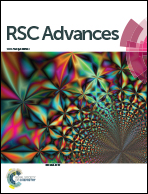Preparation and characterization of calcium phosphate/pectin scaffolds for bone tissue engineering†
Abstract
A calcium phosphate cement (CPC) scaffold has been used to repair bone defects, but its low compressive strength and poor osteogenesis greatly hinder its clinical application. Pectin is a natural, biocompatible, biodegradable, water-soluble polysaccharide that can improve the osteogenic activity of biomaterials. In this study, calcium phosphate/pectin cement (CPCP) scaffolds with different pectin concentrations (2–6%) were prepared. The results showed that changes in the pectin concentration could modulate the morphology of the CPC scaffold. Moreover, CPCP scaffolds can significantly improve the compressive strength of the CPC. For example, the compressive strength reached 28.76 MPa when the concentration of pectin was 6%, which is similar to the mechanical strength of cancellous bone. In addition, the effects of the CPCP scaffolds on cell behaviour were investigated using a model of human adipose-derived stem cells (hADSCs). Our data showed that the introduction of pectin promoted the attachment and proliferation of hADSCs in vitro. Moreover, hADSCs seeded onto the CPCP scaffold showed higher osteogenetic efficacy than those seeded onto the CPC scaffold by modulating the expression of osteogenic genes. Based on these results, a pre-clinical study was performed in New Zealand white rabbits using the cavity defect model. Furthermore, new bone could be observed surrounding the CPCP scaffold within 8 weeks. These results indicate that the CPCP scaffold has potential applications in repairing bone defects.


 Please wait while we load your content...
Please wait while we load your content...